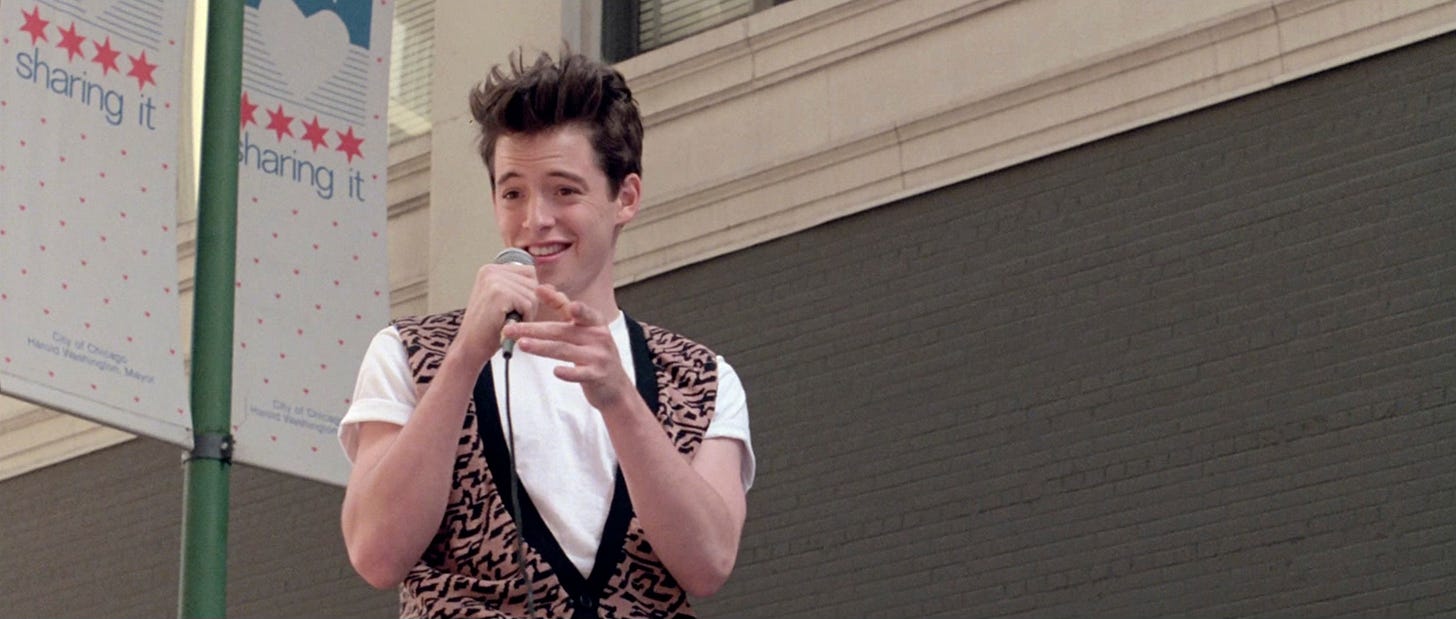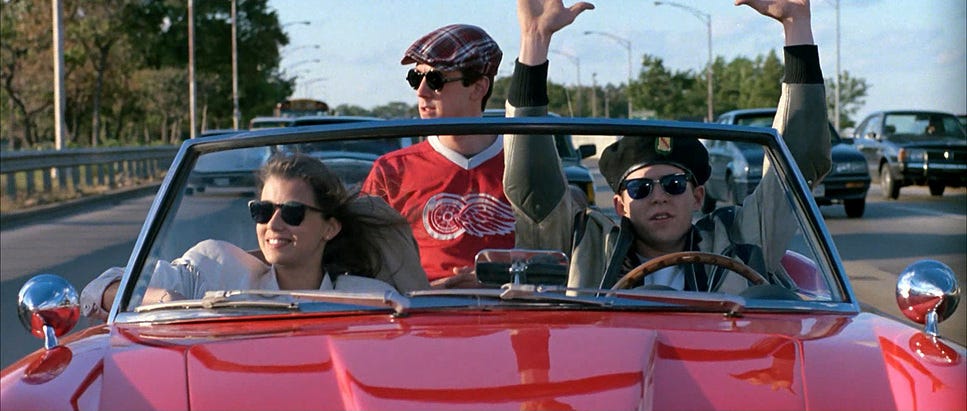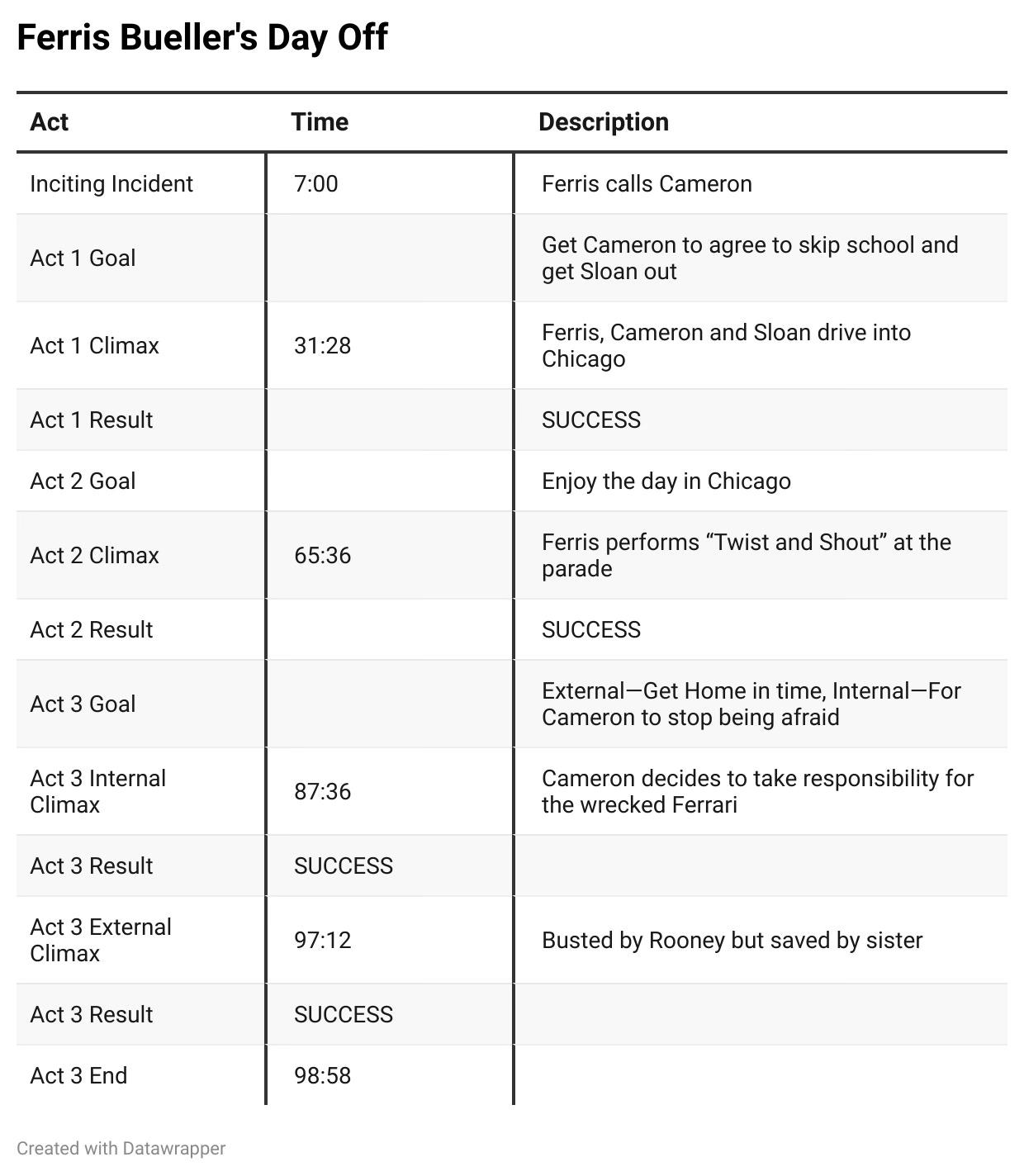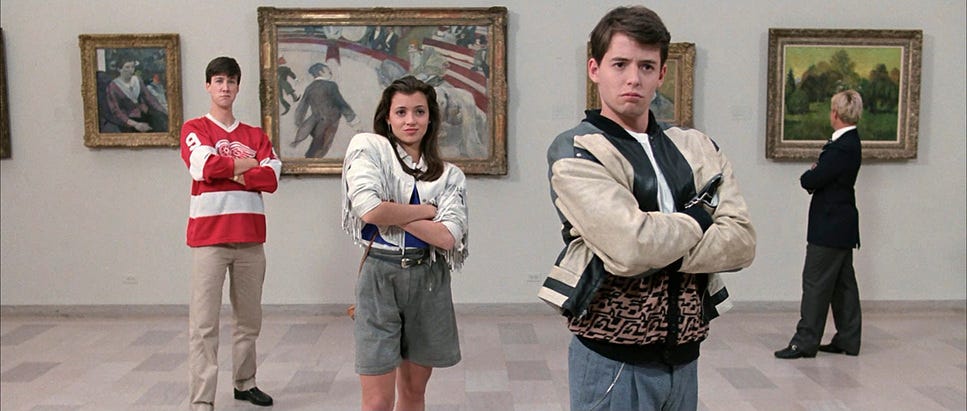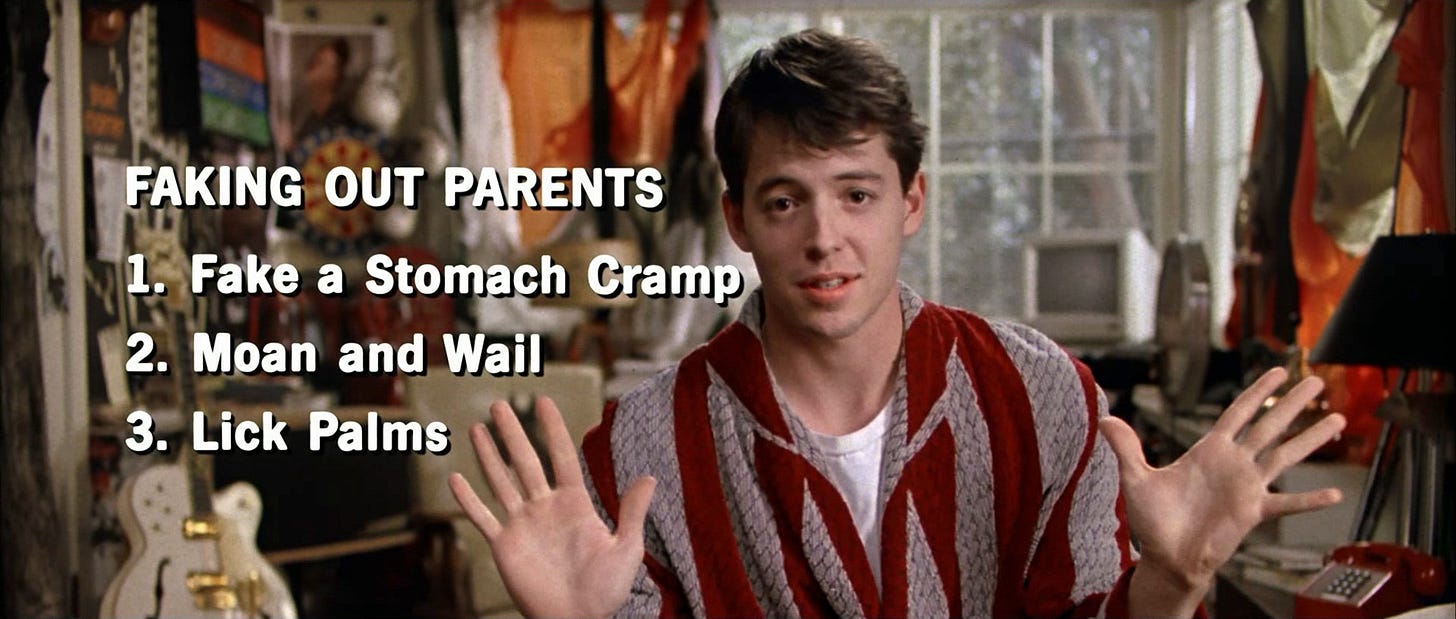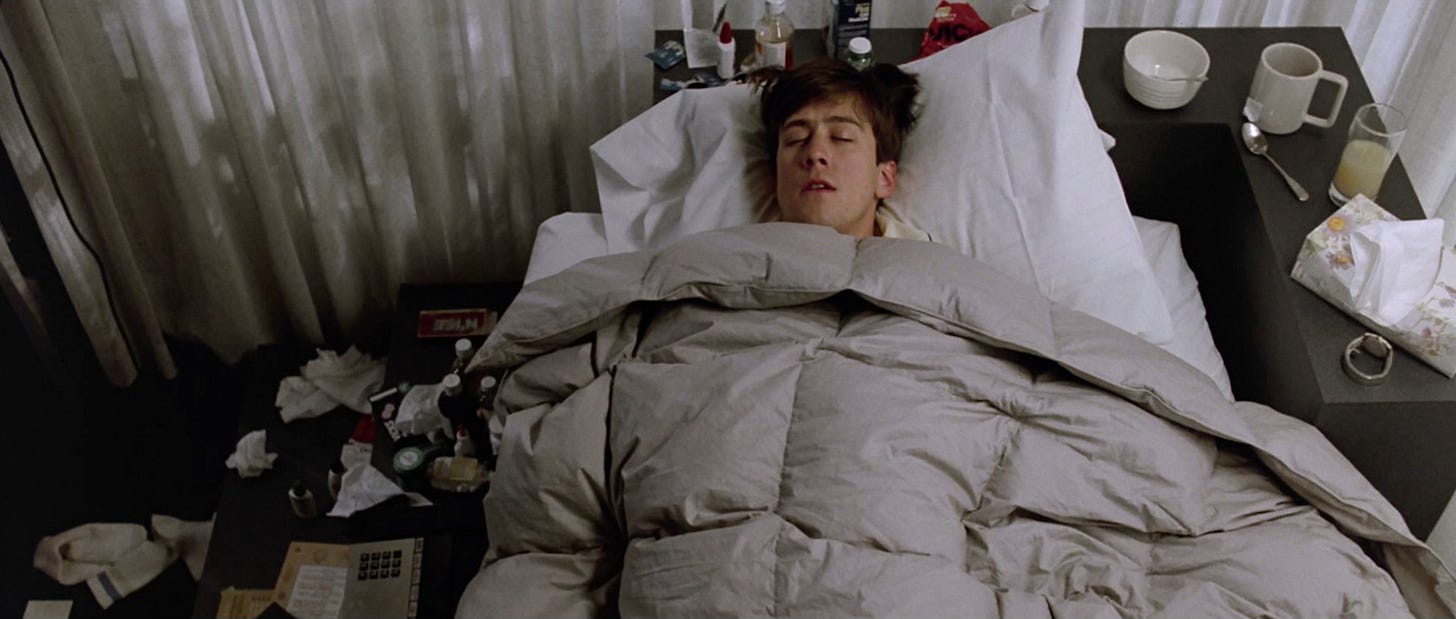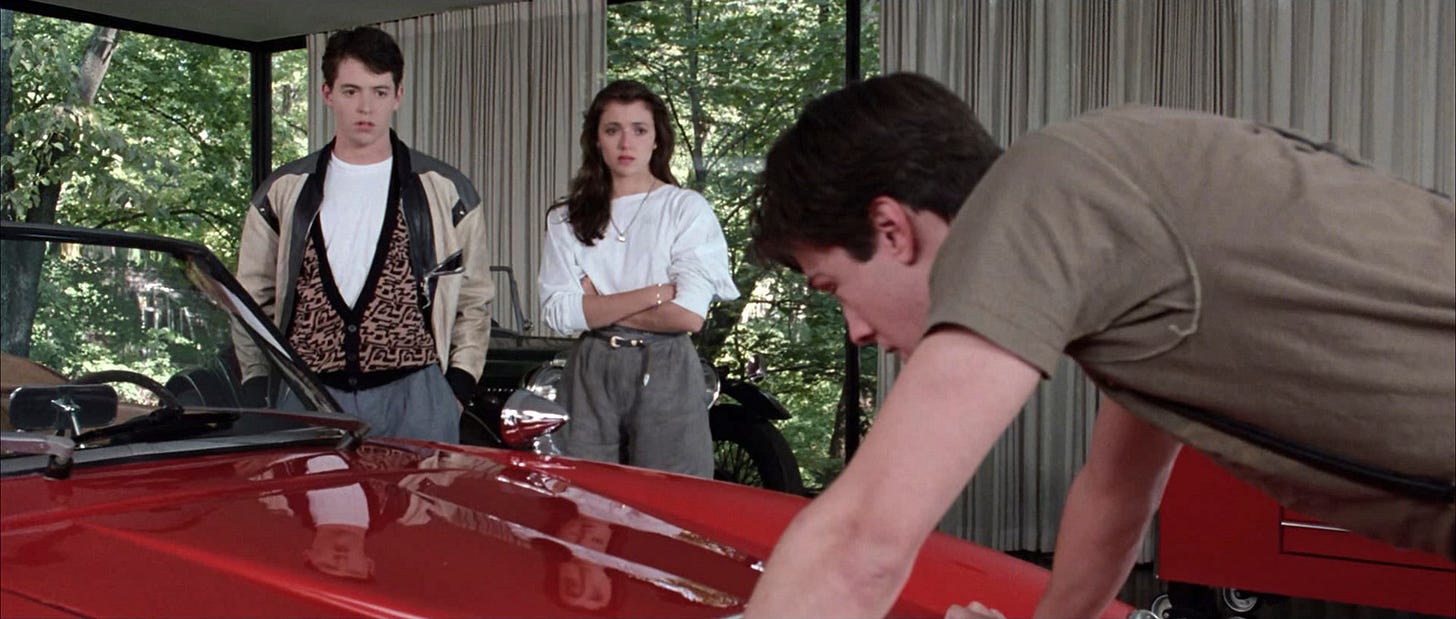Ferris Bueller's Day Off Structure Breakdown
Earlier in the year, I had the students in my Storytelling 4 class each create a structure breakdown for a movie of their choice. One of those students, Carlie Crabtree, also worked with me in the summer of 2024 to prep a bunch of future breakdowns, and to work on some of her own as well. She initially did the work on Ferris Bueller's Day Off (starring Matthew Broderick in his breakout role and written and directed by John Hughes), and I followed up with some additional observations, so this breakdown is a collaborative effort from the both of us. We hope you enjoy it!
As always, these breakdowns contain SPOILERS, and are only recommended if you've already seen the movie. You can check my introduction to these breakdowns, to get an overview of my process and philosophy.
Feel free to let me know what you think in the comments below!
The Basics
Director: John Hughes
Writer: John Hughes
Release Date: 1986
Runtime: 103 Minutes
IMDB: https://www.imdb.com/title
Movie Level Goals
External Protagonist: Ferris Bueller
External Goal: Play hooky without getting caught
SUCCESS | FAILURE | MIXED
Internal Goal Protagonist: Cameron Frye
Internal Goal: Stop living in fear
SUCCESS | FAILURE | MIXED
Goal Relationship: N/A (Ferris has a relationship with Sloan and this never changes over the course of the movie)
Three Observations
Observation #1:
Inciting incidents are unique and important aspects of feature length narrative films. Generally, they are defined as being the moment in which the status quo of the protagonist’s life changes in some form or fashion and to which the protagonist must respond in order for the plot to begin. The typical inciting incident generally occurs in the middle of the first act, somewhere around the 15 minute mark. This allows for the audience to get to know the protagonist, characters to be developed, and exposition to be revealed. Additionally, the protagonist has enough time to develop a short act one goal for the final 15 minutes or so of the first act. If the movie is structured around sequences, the inciting incident is often the climax of the first sequence. However, the inciting incident can be almost any event, from an internal decision of the protagonist to a major external event. The inciting incident can also happen anywhere in the first act or in the first couple of sequences of a movie, from the first couple of minutes all the way to the act one climax, 30 to 35 minutes into the movie. This is part of what's exciting about the exciting incident. While most movies, especially Hollywood movies have an inciting incident, there's a wide amount of flexibility and variability in how to create the inciting incident.
Ferris Bueller's Day Off has a somewhat unique inciting incident for a couple of reasons. First, it comes relatively early in the movie. When Ferris wakes up, he basically decides that he doesn't want to go to school that day. In some ways, the movie practically starts with the inciting incident. However, Ferris’s desire to skip school needs to go from an intention to an actual action. This happens when Farris calls Cameron at the seven minute mark and tells him they are going to skip school. This early inciting incident works because it is simple, relatable, and because the movie does an excellent job of developing Ferris as a character very quickly. The early inciting incident also allows for a strong act one goal, for Ferris to convince Cameron to go on an adventure and to get Sloan out of school successfully. The other unique aspect of the inciting incident is that it is an internal decision made by Ferris, and doesn't seem to have any specific motivating factor other than Ferris's desires for that particular day. This might make the inciting incident feel somewhat random, but there's nothing wrong with a random inciting incident, and it still does what a good inciting incident needs to do, which is to change the status quo for the character.
Observation #2:
In a previous breakdown on Back to the Future, we made a comparison between the characters of Marty McFly and Ferris Bueller, and the fact that both seem to be pretty much perfect, flawless characters that have no need for any sort of internal change or growth. This creates the potential danger of having a movie with less depth and meaning, since the protagonist doesn't have an internal goal or conflict. So let's take a look at how that plays out with Ferris. Perhaps even more than Marty, Ferris is the perfect, cool, high school student. While he's a thorn in the side of the principal and his sister resents him, everyone else seems to love Ferris and he has a charisma and magnetism that is infectious to everybody around him. He is completely fearless, ready to try and do anything, and has a perfect relationship with his girlfriend. Having said all of that, Ferris does seem to have some flaws that in other characters might be problematic. He can be smug, superior, and self involved. But for the most part these flaws act as strengths, especially for a high school student. He is able to outwit the annoying principal, outsmart his parents, get away with almost anything all in the service of having a good time with his friends. So where does the movie find its depth and meaning? As with Back to the Future, where the depth and meaning is found not in Marty, but in the change he instigates in his father, Ferris Bueller's Day Off finds its depth in the way in which Ferris is able to change and inspire his best friend Cameron. Cameron is a classic neurotic, anxious and afraid, unwilling to try new things, and afraid of his overbearing father. When Ferris calls Cameron, he is also skipping school, seemingly in a hypochondriacal state. In short, Cameron is a mess. Interestingly, Ferris and Cameron make odd bed fellows, but at the same time it makes sense that Ferris seems to have adopted Cameron, and the movie also seems to hint they have been lifelong friends. Over the course of the movie, Ferris initially seems to selfishly push Cameron into difficult and uncomfortable situations. Cameron seems constantly worried that they'll be caught and struggles to have a good time on their day off, but by the end of the second act he seems to have genuinely enjoyed the day. The problem comes in the final act, when Cameron discovers how many miles have been put on his father's car and worries about the consequences. This is further exacerbated when Ferris's plan to remove the miles by running the car in reverse doesn't work. In a bout of anger, Cameron begins kicking the car until he knocks it off the jack and it drives itself off the elevated carport and crashes into the yard below. Having no choice but to face the music, and inspired by everything he has done during their day off, Cameron seems to finally let go of his anxiety and is willing to face his father regardless of the consequences. This plot line gives the movie the depth and meaning it needs, allowing it to have a fun external plotline, as well as a meaningful internal plot line centered around Cameron's development and change as a character.
Observation #3:
Our third observation grows out of the relationship between Ferris’s external goal and Cameron's internal goal. Usually external success depends on internal success or vice versa. If the goal climaxes don’t depend on each other they are independent. Here though, Cameron’s internal goal of learning to not be afraid is only partially dependent on Ferris being successful at playing hooky and not getting caught. Cameron’s success at not being afraid is mostly based on playing hooky and the fun they have, and the example of Ferris’s fearless pursuit of joy. However, in Act 3, Ferris must still get home before his parents in order to not get caught. Whether or not Ferris succeeds doesn’t influence Cameron—he has already learned not to be afraid and this is independent of whether Ferris gets home in time. In fact, as the breakdown chart above shows, we can really break Act 3 into two sequences. The first sequence of Act Three is around 12 minutes and runs from the 65 minute mark, which is the end of Act Two, to approximately 87 1/2 minutes. The sequence is defined by Cameron's internal goal of letting go of his fear and anxiety. This occurs at Cameron's house, so leaves Ferris with the external goal of the second sequence of Act Three, which is to get home before his parents. This runs from the 87 1/2 minute mark to around the 99 minute mark with the climax happening around 97 minutes, when Principal Rooney catches Ferris, but his sister covers for him, allowing him to get in bed before his parents arrive. So while Cameron's success at achieving his internal goal is partially dependent on Ferris's external goal of having a successful day off, Ferris can't truly succeed at his external goal unless he gets home before his parents, which depends on him helping Cameron achieve his internal goal before he leaves Cameron's house. So in a way, the success of Ferris's external goal and Cameron's internal goal are circular with each needing to be successful in order for the other to also be successful.



